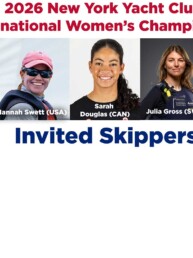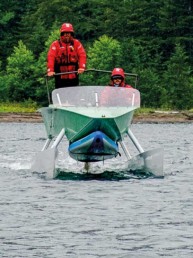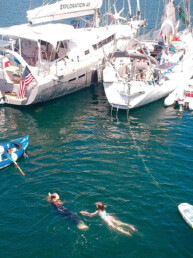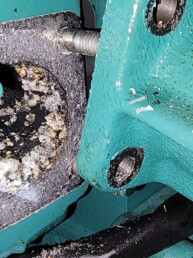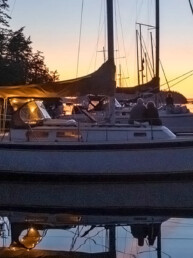CYC’s Center Sound Series Blakely Rock and Possession Point races were wild, and then much wilder. The series wraps up tomorrow with the Pulley Point Race and, for now, looks a bit more civilized in the breeze department.
Though like any day on the water in the Pacific Northwest there was meteorological variability aplenty, the top wind speeds recorded by race boats in Corinthian Yacht Club of Seattle’s March mid-distance trio—Center Sound Series—make this quite possibly the windiest start to Center Sound ever. The first of these brought sailors back to the dock grinning from ear to salt-encrusted ear. After the second race, sailors returned home grateful to have missed the worst of the blow or with an extremely real appreciation of how un-fun 50 knots of breeze is.
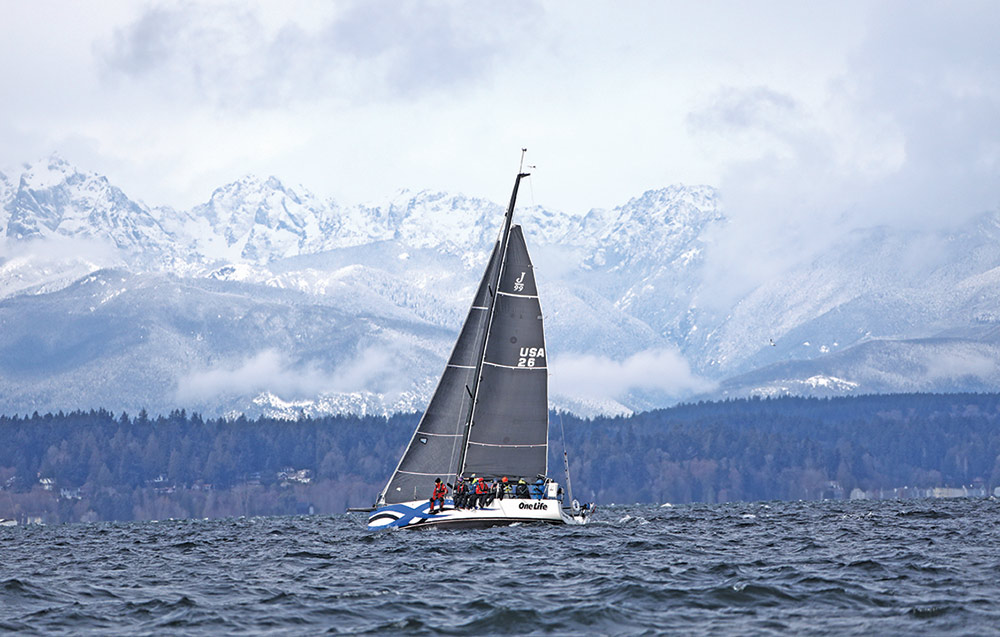
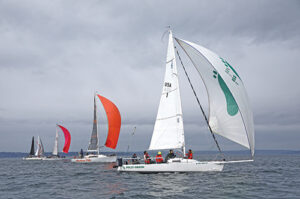
The official spring kick-off of the racing season in the Seattle area, CYC’s Blakely Rock Race opened the series on March 2, with a forecast for fresh southerly breeze. Getting out to the starting area, the fleet of 52 boats ranging from 22.5-foot J/70s to TP52s set sails in 12-14 knots. Looking out from Shilshole to where the race course would bring them, they were able to see a southerly pushing toward 20 knots. The course brought them upwind to Blakely Rock, rounding it somewhat unusually to starboard, then downwind to a temporary mark near Edmonds, before a beat back to the start/finish line.
The navigator onboard TP52 Glory, Spencer Kunath, described the first leg as “a pretty classic beat to Blakely.” With the startline close to shore, it was just a short hitch on starboard toward the breakwater before tacking to ride the lifts along the beach toward West Point.
Among the always-competitive group of nine J/105s, Creative had the highest lane and cleanest air and seemed to benefit from it during most of the beat to Bainbridge. The boats behind them traded tacks in the shifting breeze on the west side of Puget Sound, with the first boat to tack on a westerly header, Panic, making gains and eventually rounding first.
By the time the fleet reached “the Rock” the difficult choice was whether to hoist the kite on the port tack you’d be rounding on—leaving a pretty short runway before a jibe would be required—or jibe first and then hoist. Glory rounded first among the 52s and chose the port tack hoist, looking for the first available lane to jibe out. The J/105s were split, with some setting as they rounded, and others jibing first.
The clouds darkened and the wind built on the downwind leg—a white-knuckle delight for the straight-line run, but also signaling a difficult heavy-air douse in everyone’s future (if they could find the mark, which proved a challenge for some). Glory needed only one step to the east, and enjoyed a ripping high for the day of 23 knots of boat speed with their A2 spinnaker, observing as much as 29 knots of breeze. In the fleets a little farther behind them, staying west where the breeze built paid off. A ways down the run, that’s where J/105 Moose Unknown was able to make up ground on their competitors who had rounded Blakely ahead of them.
The leeward mark rounding was as pivotal as it was nervy—dousing in 25-28 knots is always a bit exciting. Glory had a hiccup with their letterbox drop, but retained enough of their lead to carry on for the class and overall ORC win. After the rounding, Moose Unknown was able to fetch the finish in the breeze decreasing to 8-15 knots—they went on to class and overall wins under the PHRF handicap. In the end, Kunath summed up a very good day of early March racing, “You’d pay a lot of money to go do that race again.”
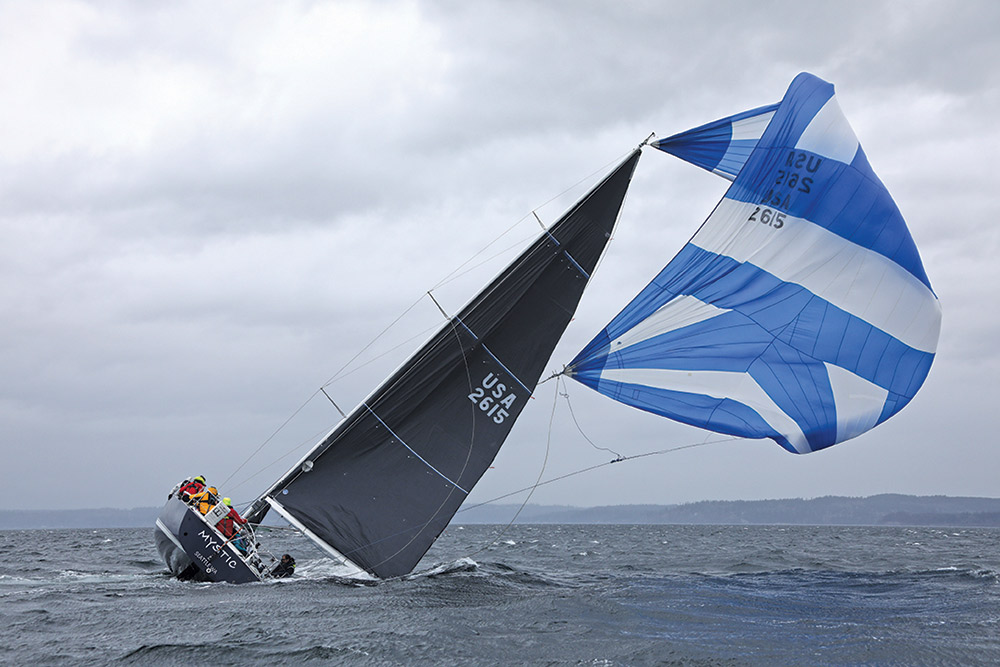
I’m not sure you could pay certain sailors to go back out for another round of the Possession Point Race on March 9, however. The fastest boats made it around the course from Shilshole Bay to the south end of Whidbey Island and back before the monster cell came in, but it was a very windy day that built to gear-bustingly massive.
Races like this year’s Possession Point are a reminder of the critical importance of all the thought and effort we put into making our boats, our crews, and ourselves safe on the water. There’s no way to predict exactly how or when the shit will hit the fan, but when it does, we rely on these various levels of preparation.
Many boats made the understandable choice to not even leave the dock with a forecast that ultimately undershot reality but still called for 30-40 knot gusts, yet 30 boats braved the March tempest. Safe seamanship was important even early on when the wind was only in the 15-25 knot range. Most notably, a crewmember went overboard from the J/105 Creative after a jibe with the kite up. Skipper Al Hughes wrote this on the J/105 Pacific Northwest fleet page: “Shortly after a jibe, we had a crew slide across the cabin top and right under the lifelines into the water. Turn up and a quick douse of the kite, good job crew! Tack around, circle the crew with the Lifesling, and we got them quickly back onboard with the transom ladder. Checked the crew physical and mental condition, put them down below with another crew for more assessment and continued on to the buoy. All reported fine below with fresh dry clothes and a strong desire to keep racing.” Those who know Al won’t be surprised by this undramatic matter-of-fact retelling, but an overboard situation with a kite up in conditions like these is a heavy scenario. Very well done to Al and the crew, securing the crew overboard so deftly—it could have been a scarier story.
Truly, the story of the race isn’t so much about the race, it’s about the survival conditions the back portion of the fleet experienced. After a day crewing and successfully finishing first-in-class on Derek DeCouteau’s Ranger 33, Aurora, our friend Kurt Hoehne wrote on his website Sailish.com: “Let’s just call it 50 knots of breeze. Anecdotally, reports came in of 50 knots of windspeed. Some said 48. On the water it seemed every bit of 50…. There was a distinct line of demarcation when the biggest wind hit—boats behind that line were scattered with ripped sails, crews on the foredeck holding downed headsails while hoping it would soon be over. Some boats were trying to motor under bare poles. Some limped to the finish after the worst of it passed. And the J/109 Eclipse broke her mast.”
In the end, it was a race and some boats did actually finish without incident. Scott Smith, one of the vastly experienced crew aboard the Farr 36, Annapurna, shared, “Everything that was thrown at us was handled in a calm, efficient manner and despite some not-so-normal conditions, all was good.” Overall honors for the day went to the J/111 Lodos in the ORC fleet and Hobie 33 TC amongst the PHRF boats. After a day like that, I’m mainly glad everyone is home safe, but congrats nonetheless to those who finished and finished well!
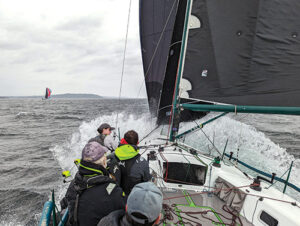
Woof, who knows what else March might hurl at these Center Sound racers. They’ve got one more event that will take place after this magazine goes to press. I bet I’m not the only one keeping fingers crossed for some blissful champagne sailing to round out the series. Or, sure, one more epic day to complete the set!
Results at cycseattle.org
Photos by Jan Anderson.
Joe Cline
Joe Cline has been the Managing Editor of 48° North since 2014. From his career to his volunteer leadership in the marine industry, from racing sailboats large and small to his discovery of Pacific Northwest cruising —Joe is as sail-smitten as they come. Joe and his wife, Kaylin, have welcomed a couple of beautiful kiddos in the last few years, and he is enjoying fatherhood while still finding time to make a little music and even occasionally go sailing.

